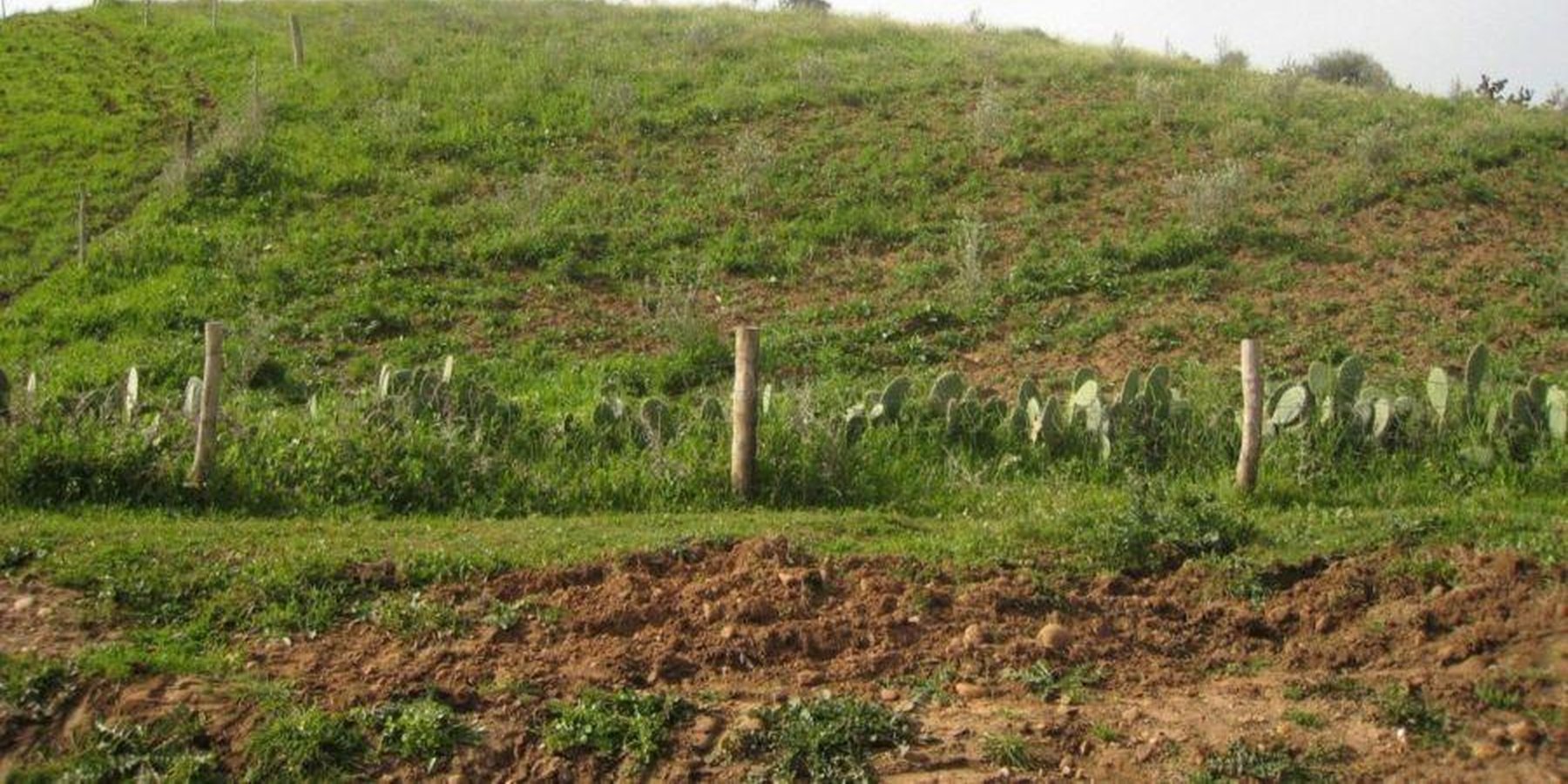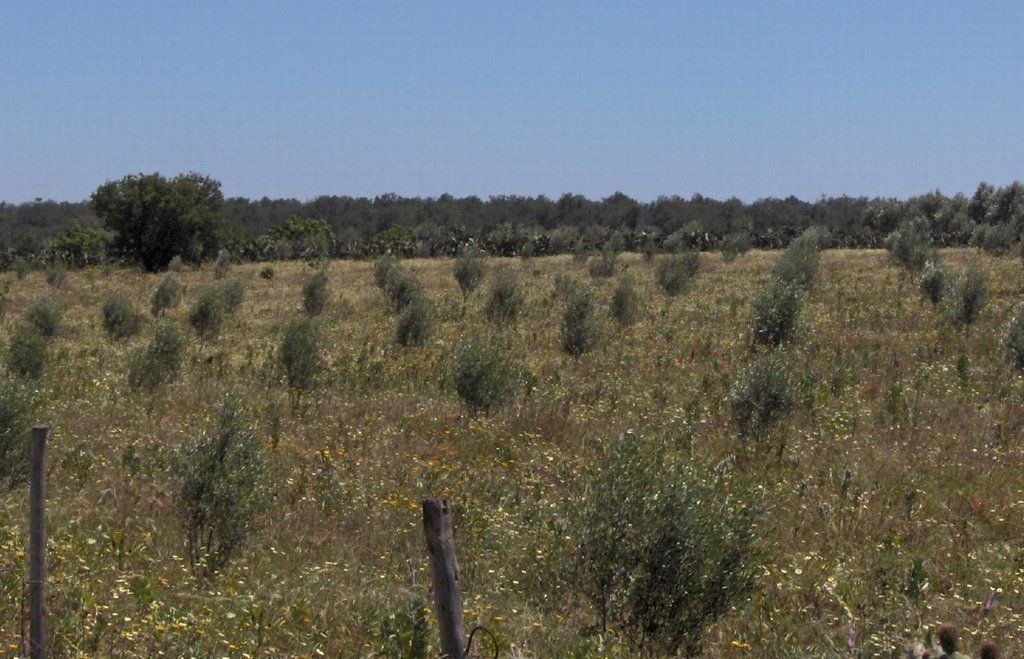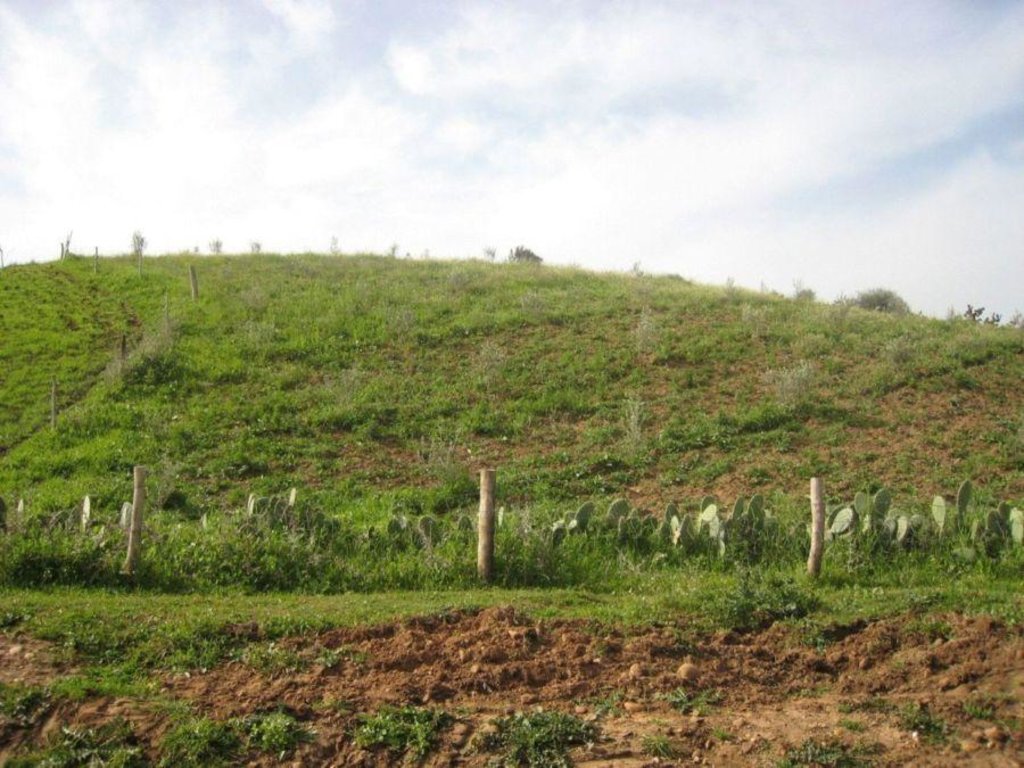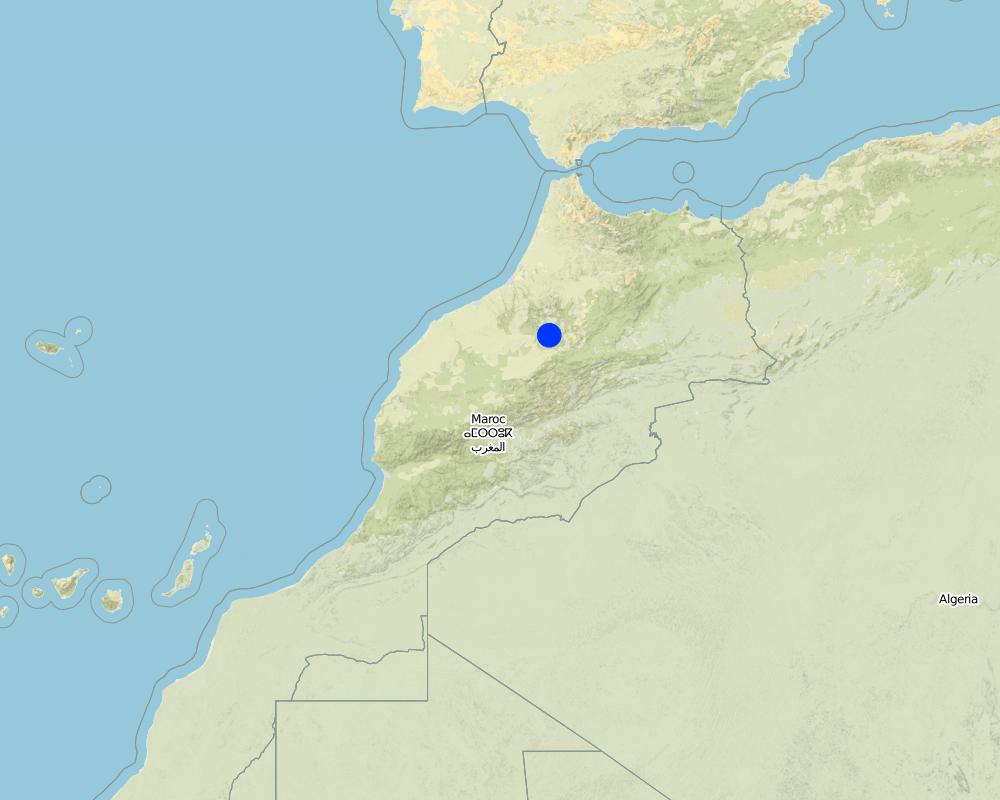Development of rainfed agriculture [Morocco]
- Creation:
- Update:
- Compiler: Rachida Nafaa
- Editor: –
- Reviewers: David Streiff, Deborah Niggli
Projet de mise en valeur en Bour de Sehoul (PMVB) (french)
approaches_2421 - Morocco
View sections
Expand all Collapse all1. General information
1.2 Contact details of resource persons and institutions involved in the assessment and documentation of the Approach
SLM specialist:
Name of project which facilitated the documentation/ evaluation of the Approach (if relevant)
DESIRE (EU-DES!RE)Name of the institution(s) which facilitated the documentation/ evaluation of the Approach (if relevant)
Université Mohammed V Agdal, Faculté des Lettres (Université Mohammed V Agdal, Faculté des Lettres)1.3 Conditions regarding the use of data documented through WOCAT
When were the data compiled (in the field)?
29/01/2009
The compiler and key resource person(s) accept the conditions regarding the use of data documented through WOCAT:
Yes
1.4 Reference(s) to Questionnaire(s) on SLM Technologies
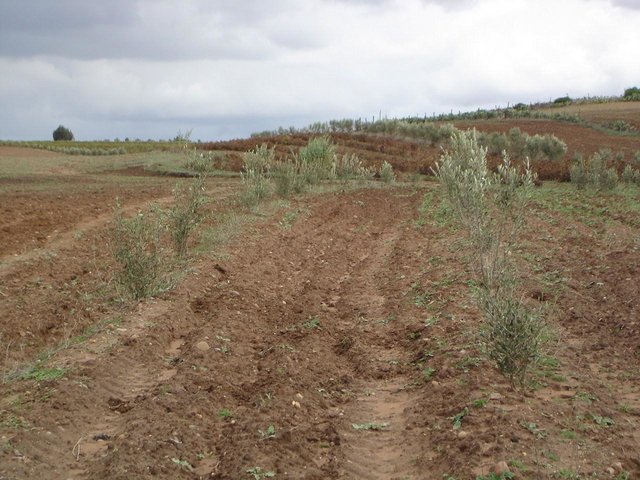
Olive tree plantations with intercropping [Morocco]
Contour planting of olive trees with crops, legumes and vegetables intercropping
- Compiler: Laouina Abdellah
2. Description of the SLM Approach
2.1 Short description of the Approach
Development of unfavourable zones by integrating all components which can enhance the production, increase incomes and provide a sustainable natural resources management.
2.2 Detailed description of the Approach
Detailed description of the Approach:
Aims / objectives: The main objectives are to involve all the partners in the development of rainfed agriculture, the conservation of the natural resources, the enhancement of crop and animal agricultural production, the increase in income and improvement of farmers’ conditions of life, and a better response to the needs and protection of the production potential. A further aim is the integration of the local agriculture into the national context and the opening up to the outside world.
Stages of implementation: The implementation of the project goes through several phases including:
- The identification phase of people's needs and farming or environmental problems of the region.
- Formulation of the proposed development by a committee of administrators and local stakeholders.
- Feasibility study and planning of the implementation steps in technical terms.
- Implementation of project components after the effective registration of the project in the Finance Act, with distribution of tree seedlings and support for the establishment of water harvesting structures for olive trees on sloping land.
- Assistance of project operation and maintenance. The aim is to support farmers’ organisations benefiting from the project in order to develop their necessary skills for efficient project operation, establishment and maintenance and other issues that can ensure sustainability.
- Evaluation of the completed project in order to capitalize on the experience gained during preparation and execution of the project.
Role of stakeholders: - Land users: participation in the consultations made by the SLM specialists, who are responsible for monitoring the projects.
- SLM specialists / agricultural advisors: implementation of the technology after consultation with the population.
- Politicians / decision makers: discussion with the population
- Planners: Participatory diagnosis, meetings with target population, questionnaires
2.3 Photos of the Approach
2.5 Country/ region/ locations where the Approach has been applied
Country:
Morocco
Region/ State/ Province:
Salé province
Further specification of location:
Sehoul
Comments:
The development project of rainfed agriculture concern the whole Sehoul community.
Map
×2.6 Dates of initiation and termination of the Approach
Indicate year of initiation:
2001
Year of termination (if Approach is no longer applied):
2004
2.7 Type of Approach
- project/ programme based
2.8 Main aims/ objectives of the Approach
The Approach focused mainly on SLM with other activities (- Activités génératrices de revenu - Correction des ravins - Intensification de la production animale par l'amélioration génétique de races locales bovines et ovines - alimentation et soins vétérinaires)
- Increase in land users’ incomes
- Intensification of agricultural production (animal and crops)
- Opening up of the region to form a national and worldwide perspective, and remove its marginality
The SLM Approach addressed the following problems: Cereal crops only provide irregular incomes (due to the frequency of bad years) and they cause degradation on sloping land, because the ground is bare at the beginning of the rainy season. Pasture, the second activity in terms of land use, but the primary activity in terms of history and incomes, also causes land degradation. Tree crop harvesting is therefore an economic and ecological alternative. The tree plantations should therefore be implemented with SWC measures, which requires know-how that is unfortunately still lacking. The goal of the project is to overcome this lack of knowledge.
2.9 Conditions enabling or hindering implementation of the Technology/ Technologies applied under the Approach
social/ cultural/ religious norms and values
- hindering
Distrust of the population due to the fear of land expropriations
Treatment through the SLM Approach: Participative approach to gain the confidence of the population
availability/ access to financial resources and services
- hindering
High costs for the technology implementation for a mainly poor population
Treatment through the SLM Approach: Bearing the technology implementation costs by the project
legal framework (land tenure, land and water use rights)
- hindering
Act on private lands belonging to people who fear land expropriation during the project
Treatment through the SLM Approach: Contracts between the beneficiaries and the project about the duties of each stakeholder
The existing land ownership, land use rights / water rights hindered a little the approach implementation It was difficult to act on private land because of the fear of land expropriation by the project.
knowledge about SLM, access to technical support
- hindering
Lack of know-how in modern agroforestry
Treatment through the SLM Approach: Agricultural extension and support for users who perform this new land use
other
- hindering
Extensive pastoralism based on grazing in fallow land, stubble fields and Mediterranean vegetation is reduced, what causes conflicts among inhabitants
Treatment through the SLM Approach: Incentive measures for animal housing and fodder cultivation
3. Participation and roles of stakeholders involved
3.1 Stakeholders involved in the Approach and their roles
- community-based organizations
Only men participated in the approach
- SLM specialists/ agricultural advisers
- teachers/ school children/ students
- national government (planners, decision-makers)
At the national scale, this approach is implemented by the Ministry of Agriculture as part of the 33-94 law about PMVB
3.2 Involvement of local land users/ local communities in the different phases of the Approach
| Involvement of local land users/ local communities | Specify who was involved and describe activities | |
|---|---|---|
| initiation/ motivation | none | |
| planning | interactive | Participative assessment, meetings with the target population, questionnaires |
| implementation | external support | This is achieved by SLM specialists appointed by the implementing bodies of the Ministry of Agriculture |
| monitoring/ evaluation | none | |
| Research | none |
3.3 Flow chart (if available)
Description:
Legally, the project of rainfed agriculture development (PMVB) is based on the 33-94 law, which is coordinated by the Directorate of Management in the Ministry of Agriculture.
Author:
Antari Elmostafa, Rabat, Morocco (Sehoul, Province: Salé)
3.4 Decision-making on the selection of SLM Technology/ Technologies
Specify who decided on the selection of the Technology/ Technologies to be implemented:
- mainly SLM specialists, following consultation with land users
Explain:
The project is based on assessment of population propositions made during the participative process with SLM specialists. Then the technology implementation is done in cooperation with the interested land user.
Decisions on the method of implementing the SLM Technology were made by by SLM specialists alone (top-down). Once the technology adopted by the farmers, realization is done by SLM specialists mandated by the implementing bodies (Direction Provinciale d'Agriculture, Centre des Travaux agricoles, Office Régional de Mise en Valeur Agricole).
4. Technical support, capacity building, and knowledge management
4.1 Capacity building/ training
Was training provided to land users/ other stakeholders?
Yes
Form of training:
- farmer-to-farmer
Subjects covered:
Training was conducted through site visits and farmer to farmer. Training focused on soil working, use of productive seeds, fertilization, livestock genetic improvement, livestock accompaniment.
4.2 Advisory service
Do land users have access to an advisory service?
Yes
Specify whether advisory service is provided:
- on land users' fields
Describe/ comments:
Name of method used for advisory service: Agricultural extension; Key elements: Neighbourhood services ensured by the local technicians, Field trips to the land users, Livestock vaccination campaigns
Advisory service is very adequate to ensure the continuation of land conservation activities; The extension system is entirely adequate to ensure continuation of activities. The external services of the Ministry of Agriculture are responsible each year for the distribution of olive tree seedlings with 80% subsidies to enhance land users’ planting efforts.
4.3 Institution strengthening (organizational development)
Have institutions been established or strengthened through the Approach?
- yes, moderately
Specify the level(s) at which institutions have been strengthened or established:
- local
Give further details:
population organisations
4.4 Monitoring and evaluation
Is monitoring and evaluation part of the Approach?
Yes
Comments:
Bio-physical aspects were ad hoc monitored by project staff through observations
Technical aspects were ad hoc monitored by project staff through observations
Economic / production aspects were ad hoc monitored by project staff through measurements
No. of land users involved aspects were regular monitored by project staff through measurements
Management of Approach aspects were ad hoc monitored by project staff through measurements
There were no changes in the Approach as a result of monitoring and evaluation
There were no changes in the Technology as a result of monitoring and evaluation
4.5 Research
Was research part of the Approach?
Yes
Give further details and indicate who did the research:
Academic research on different parts of the project
Research was carried out both on station and on-farm
5. Financing and external material support
5.1 Annual budget for the SLM component of the Approach
If precise annual budget is not known, indicate range:
- 100,000-1,000,000
Comments (e.g. main sources of funding/ major donors):
Approach costs were met by the following donors: international (World Bank, FAO): 30.0%; local government (district, county, municipality, village etc) (Ministry of Agriculture): 70.0%
5.2 Financial/ material support provided to land users
Did land users receive financial/ material support for implementing the Technology/ Technologies?
Yes
If yes, specify type(s) of support, conditions, and provider(s):
The private sector did not really participate; only farmers participated by their work.
5.3 Subsidies for specific inputs (including labour)
- agricultural
| Specify which inputs were subsidised | To which extent | Specify subsidies |
|---|---|---|
| Fruit trees seeds | fully financed | |
If labour by land users was a substantial input, was it:
- paid in cash
Comments:
Local workforce employed for the project is paid in cash for all the work achieved.
5.4 Credit
Was credit provided under the Approach for SLM activities?
No
6. Impact analysis and concluding statements
6.1 Impacts of the Approach
Did the Approach help land users to implement and maintain SLM Technologies?
- No
- Yes, little
- Yes, moderately
- Yes, greatly
farmers’ income increased after olive tree planting.
Did the Approach improve issues of land tenure/ user rights that hindered implementation of SLM Technologies?
- No
- Yes, little
- Yes, moderately
- Yes, greatly
The project approach is based on incentives like contracting procedures and total financing of technology implementations done on private lands.
Did other land users / projects adopt the Approach?
- No
- Yes, little
- Yes, moderately
- Yes, greatly
land users showed an increasing interest after the PMVB implementation.
Did the Approach lead to improved livelihoods / human well-being?
- No
- Yes, little
- Yes, moderately
- Yes, greatly
incomes have been improved a little, for the few land users who have initially implemented this approach. This includes, however, only a small part of the population.
Did the Approach help to alleviate poverty?
- No
- Yes, little
- Yes, moderately
- Yes, greatly
because the small farmers and landless peasants have not really benefited from the PMVB approach.
6.2 Main motivation of land users to implement SLM
- increased production
- increased profit(ability), improved cost-benefit-ratio
- payments/ subsidies
6.3 Sustainability of Approach activities
Can the land users sustain what has been implemented through the Approach (without external support)?
- yes
6.4 Strengths/ advantages of the Approach
| Strengths/ advantages/ opportunities in the land user’s view |
|---|
| Financial support to help poor land users to implement SLM technologies (How to sustain/ enhance this strength: Subsidies for expensive SLM activities) |
| L'accompagnement des exploitants (How to sustain/ enhance this strength: Strengthen local structures in charge of agricultural extension) |
| Strengths/ advantages/ opportunities in the compiler’s or other key resource person’s view |
|---|
| Development of assessment abilities at local and central scale (How to sustain/ enhance this strength: Spreading this assessment abilities and reinforce them) |
| Implication of all local stakeholders and national or international beneficiaries (How to sustain/ enhance this strength: Strengthen the cooperation between the private sector and every potential stakeholder) |
| Wide coverage of diverse agro-ecological zones (How to sustain/ enhance this strength: Approach extension towards the most disadvantaged agro-ecological zones) |
| Creation of a local dynamic (How to sustain/ enhance this strength: Support stakeholders organizations) |
6.5 Weaknesses/ disadvantages of the Approach and ways of overcoming them
| Weaknesses/ disadvantages/ risks in the land user’s view | How can they be overcome? |
|---|---|
| Inadequate government subsidies | The government has to provide help in order to meet the needs (fodder, support for poor land users) in order to implement SLM activities, to change land uses or to adopt more profitable cultivation |
| Few training and supervision for young people | Incentive measures for young people and women through developing their human capacities |
| Weaknesses/ disadvantages/ risks in the compiler’s or other key resource person’s view | How can they be overcome? |
|---|---|
| Few synergies between all development actors | Because of the proximity of Rabat and Salé, the management of this region is done from the cities. Local autonomy can be a first step in more local development involvement. |
| Low level of involvement of local stakeholders | Elected local people have to integrate agricultural development programmes in their global strategies and not only suggest services in order to win the elections |
| Lack of agricultural strategies for this region, which is impaired by the nearby growing urbanization | Agriculture should not only be planned when needs are dictated by the cities of Rabat and Salé (primarily horticulture) |
7. References and links
7.1 Methods/ sources of information
- field visits, field surveys
- interviews with land users
7.2 References to available publications
Title, author, year, ISBN:
Le PMVB des Sehoul, evaluation, Ministère de l’Agriculture, Direction Provinciale de l’Agriculture, Rabat-Salé, 2003.
Links and modules
Expand all Collapse allLinks

Olive tree plantations with intercropping [Morocco]
Contour planting of olive trees with crops, legumes and vegetables intercropping
- Compiler: Laouina Abdellah
Modules
No modules


